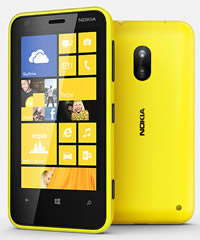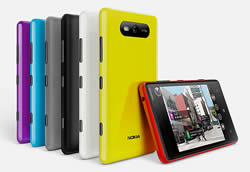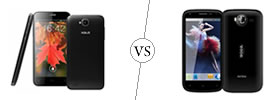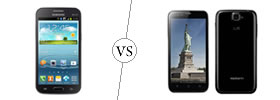Difference between Nokia Lumia 620 and Nokia Lumia 820
Key difference: One of the newest smartphones under the brand is the Nokia Lumia 620. Nokia Lumia 620 is aimed at the entry-level buyers who want to try a Windows Phone 8 but can’t afford to spend too much on it. One of the first smartphones under the brand is the Nokia Lumia 820. The Nokia Lumia 820 was first of the first phones to be developed running on Windows Phone 8. It was launched in November 2012, as a slightly cheaper alternative to the Nokia 920.
 Nokia, the Finnish multinational communications and information technology corporation, is known for it highly durable mobile phones. However, with the increasing onset of smartphones, the sales of Nokia’s simple but durable phones started to drop. To offset this trend, Nokia tied up with Microsoft to launch a series of smartphones based on Microsoft’s Windows. This series of phones branded as Nokia Lumia run on Microsoft Windows Mobile 8.
Nokia, the Finnish multinational communications and information technology corporation, is known for it highly durable mobile phones. However, with the increasing onset of smartphones, the sales of Nokia’s simple but durable phones started to drop. To offset this trend, Nokia tied up with Microsoft to launch a series of smartphones based on Microsoft’s Windows. This series of phones branded as Nokia Lumia run on Microsoft Windows Mobile 8.
One of the newest smartphones under the brand is the Nokia Lumia 620. Nokia Lumia 620 is aimed at the entry-level buyers who want to try a Windows Phone 8 but can’t afford to spend too much on it. The phone is a decent enough piece of merchandise, especially considering its price. It features a 3.8-inch screen with a resolution of 480 x 800 pixels. It features a Qualcomm Snapdragon S4 Dual-core 1 GHz Krait and a 512 MB RAM. It has an 8 GB internal storage capacity and an external storage expandable up to 64 GB.
The Nokia Lumia 620 has a 5 MP camera with auto focus and LED flash, as well as a secondary front-facing VGA camera. The phone like most of the phones under the Lumia brand is available in a variety of bright colors, such as lime green, orange, magenta, yellow, cyan, and the usually white and black. In fact, the phone comes with back panels in these colors allowing the user to change the phone’s color every few days.
However, the phone has been criticized as looking a bit plasticky and cheap. The phone is also a bit on the heavier side. Another issue with the phone, in fact all the Windows phones, is that it comes with the Internet Explorer browser built-in, which can be quite lagging at times, and the phones do not support any other browsers. Furthermore, the collection of apps available on Windows is quite limited, especially as compared to the apps available for Android and Apple.
One of the first smartphones under the brand is the Nokia Lumia 820. The Nokia Lumia 820 was first of the first phones to be developed running on Windows Phone 8. It was launched in November 2012, as a slightly cheaper alternative to the Nokia Lumia 920. It has a 4.3 inch display with a resolution of 480 x 800 pixels. It is powered by a Qualcomm MSM8960 Snapdragon Dual-core 1.5 GHz Krait processor and a 1 GB RAM. The phone has 8 GB internal memory and an external memory expandable up to 64 GB.
 Nokia Lumia 820 features an 8 MP primary camera with autofocus and dual-LED flash, as well as Carl Zeiss optics. It also has a VGA secondary front-facing camera for self photo shots and video calling. The phone is available in a variety of bright colors, such as black, gray, red, yellow, white, blue, and violet. In fact, the phone comes with back panels in these colors allowing the user to change the phone’s color every few days.
Nokia Lumia 820 features an 8 MP primary camera with autofocus and dual-LED flash, as well as Carl Zeiss optics. It also has a VGA secondary front-facing camera for self photo shots and video calling. The phone is available in a variety of bright colors, such as black, gray, red, yellow, white, blue, and violet. In fact, the phone comes with back panels in these colors allowing the user to change the phone’s color every few days.
The newest and most distinguishing feature of the Lumia 820 is that the phone is capable of wireless charging. However, the wireless charging mat is not included with the phone and has to be purchased separately.
However, the phone has been criticized as being chunky and heavy. Another issue with the phone, in fact all the Windows phones, is that it comes with the Internet Explorer browser built-in, which can be quite lagging at times, and the phones do not support any other browsers. Furthermore, the collection of apps available on Windows is quite limited, especially as compared to the apps available for Android and Apple.
The information for the detailed table about the two phones has been taken from the Nokia website, cnet.co.uk, techradar.com, and GSMArena.com.
|
|
Nokia Lumia 620 |
Nokia Lumia 820 |
|
Launch Date |
January 2013 |
November 2012 |
|
Company |
Nokia |
Nokia |
|
Size |
115.4 x 61.1 x 11 mm, 76 cc (4.54 x 2.41 x 0.43 in) |
123.8 x 68.5 x 9.9 mm, 83.5 cc (4.87 x 2.70 x 0.39 in) |
|
Display |
TFT capacitive touchscreen, 16M colors |
AMOLED capacitive touchscreen, 16M colors |
|
Screen |
480 x 800 pixels, 3.8 inches (~246 ppi pixel density) |
480 x 800 pixels, 4.3 inches (~217 ppi pixel density) |
|
Protection |
ClearBlack display |
ClearBlack display |
|
Weight |
127 g (4.48 oz) |
160 g (5.64 oz) |
|
2G Network |
GSM 850 / 900 / 1800 / 1900 |
GSM 850 / 900 / 1800 / 1900 |
|
3G Network |
HSDPA 850 / 900 / 1900 / 2100 |
HSDPA 850 / 900 / 1900 / 2100 |
|
4G Network |
No |
LTE 800 / 900 / 1800 / 2100 / 2600 |
|
GUI |
Windows Phone 8 |
Windows Phone 8 |
|
CPU speed |
Dual-core 1 GHz Krait |
Dual-core 1.5 GHz Krait |
|
GPU |
Adreno 305 |
Adreno 225 |
|
OS |
Microsoft Windows Phone 8 |
Microsoft Windows Phone 8 |
|
Chipset |
Qualcomm Snapdragon S4 |
Qualcomm MSM8960 Snapdragon |
|
RAM |
512 MB RAM |
1 GB RAM |
|
SIM Size |
Micro-SIM |
Micro-SIM |
|
Internal Memory |
8 GB |
8 GB |
|
Expandable Memory |
microSD, up to 64 GB |
microSD, up to 64 GB |
|
Sensors |
Accelerometer, compass, Polarization filter, Brightness control, Orientation sensor, Proximity sensor, RGB Stripe, Sunlight readability enhancements, Color boosting, Ambient light sensor |
Accelerometer, gyro, proximity, compass |
|
Connectivity |
Micro-USB charging connector, 3.5 mm audio connector, Micro-USB-B connector, USB 2.0, Bluetooth 3.0, Wi-Fi, NFC |
Micro-USB charging connector, 3.5 mm audio connector, Micro-USB-B connector, USB 2.0, Bluetooth 3.0, Wi-Fi, NFC, Wi-Fi Channel bonding |
|
Data |
GPRS, EDGE, WLAN, Bluetooth, USB, NFC |
GPRS, EDGE, WLAN, Bluetooth, USB, NFC |
|
Speed |
HSDPA, 21 Mbps; HSUPA, 5.76 Mbps |
HSDPA, 42 Mbps; HSUPA, 5.76 Mbps; LTE, Cat3, 50 Mbps UL, 100 Mbps DL |
|
WLAN |
Wi-Fi 802.11 a/b/g/n, dual-band |
Wi-Fi 802.11 a/b/g/n, dual-band, Wi-Fi Direct |
|
Bluetooth |
Yes, v3.0 with A2DP, EDR |
Yes, v3.1 with A2DP, EDR |
|
USB |
microUSB v2.0 |
microUSB v2.0 |
|
Primary Camera |
5 MP, 2592х1936 pixels, autofocus, LED flash |
8 MP, 3264x2448 pixels |
|
Secondary Camera |
VGA - 640 x 480 pixels |
Yes, VGA |
|
Video |
Yes, 720p@30fps |
Yes, 1080p@30fps, video stabilization |
|
Camera Features |
Touch focus, Landscape orientation, Auto and manual white balance, Still image editor, Geotagging |
Carl Zeiss optics, autofocus, dual-LED flash, Geo-tagging, touch focus |
|
Sound Enhancement |
Active noise cancellation with dedicated mic, Audio Equalizer |
Dolby Headphone sound enhancement, Active noise cancellation with dedicated mic |
|
Audio supported formats |
MP3, AMR-WB, AMR-NB, WMA 10 Pro, WMA 9, AAC LC, AAC+/HEAAC, eAAC+/HEAACv2 |
Codecs: MP3, AMR-WB, AMR-NB, WMA 10 Pro, WMA 9, AAC LC, AAC+/HEAAC, eAAC+/HEAACv2 Audio playback file formats: ASF, MP4, AAC, AMR, MP3, M4A, WMA, 3GP, 3G2 |
|
Video supported formats |
VC-1, H.264/AVC, H.263, MPEG-4; MP4, WMV, 3GP, M4V |
Video playback codecs: VC-1, H.264/AVC, H.263, MPEG-4 Video playback file formats: MP4, WMV, 3GP, M4V Video recording formats: MP4/H.264 |
|
Battery Capacity |
Li-Ion 1300 mAh battery (BL-4J) |
Li-Ion 1650 mAh battery (BP-5T) |
|
Stand-by |
330 h |
360 h |
|
Talk time |
2G talk time: 14.6 h 3G talk time: 9.9 h |
2G talk time: 15.4 h 3G talk time: 8.1 h |
|
Available Colors |
Lime green, orange, magenta, yellow, cyan, white, black |
Black, Gray, Red, Yellow, White, Blue, Violet |
|
Messaging |
SMS (threaded view), MMS, Email, Push Email, IM |
SMS (threaded view), MMS, Email, Push Email, IM |
|
Browser |
HTML5 |
HTML5 |
|
Radio |
No |
No |
|
GPS |
Yes, with A-GPS support and GLONASS |
Yes, with A-GPS support and GLONASS |
|
Java |
No |
No |
|
Additional Features |
|
|
Image Courtesy: nokia.com









Add new comment